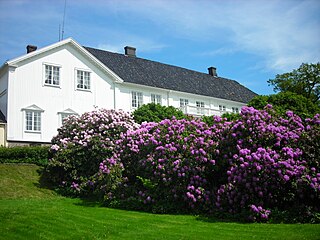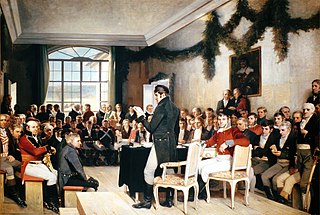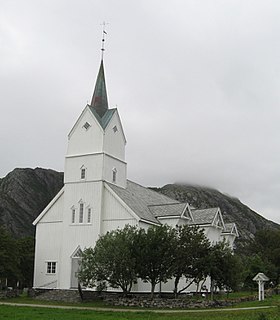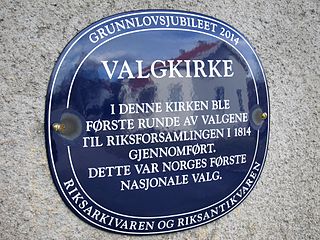
The Constitution of Norway was adopted on 16 May and signed on 17 May 1814 by the Norwegian Constituent Assembly at Eidsvoll.

Eidsvoll is a municipality in Akershus in Viken county, Norway. It is part of the Romerike traditional region. The administrative centre of the municipality is the village of Sundet.

Henrik Arnold Thaulow Wergeland was a Norwegian writer, most celebrated for his poetry but also a prolific playwright, polemicist, historian, and linguist. He is often described as a leading pioneer in the development of a distinctly Norwegian literary heritage and of modern Norwegian culture.

The history of Jews in Norway dates back to the 1400s. Although there were very likely Jewish merchants, sailors and others who entered Norway during the Middle Ages, no efforts were made to establish a Jewish community. Through the early modern period, Norway, still devastated by the Black Death, was ruled by Denmark from 1536 to 1814 and then by Sweden until 1905. In 1687, Christian V rescinded all Jewish privileges, specifically banning Jews from Norway, except with a special dispensation. Jews found in the kingdom were jailed and expelled, and this ban persisted until 1851.

Bergen Cathedral School is an upper secondary school in Bergen, Norway. Located in the city centre, next to Bergen Cathedral, the school has about 850 students, 95 full-time teachers, and 5 administration personnel, including the headmaster, Lise Hårklau Holsen.

Carsten Tank was a Norwegian businessman and politician who served as Norwegian councilor of government of the 1st Ministry, and later councilor of state of the same ministry.

The Norwegian Constituent Assembly is the name given to the 1814 Constitutional Assembly at Eidsvoll in Norway, that voted the Norwegian Constitution and formalised the dissolution of the union with Denmark. In Norway, it is often just referred to as Eidsvollsforsamlingen, which means The Assembly of Eidsvoll.

The Battle of the Square was a skirmish between Norwegian demonstrators and forces of the United Kingdoms of Sweden and Norway that took place in Christiania in the evening of 17 May 1829.

Per Kristian Skulberg is a Norwegian physician and politician. As former State Secretary in the Norwegian Ministry of Environment and in the Norwegian Ministry of Culture he has contributed within the field of heritage interpretation as basis for improved environmental management.
Events in the year 1814 in Norway.

Oscar Arnold Wergeland was a Norwegian painter. He is best known for his historical painting of the Constituent Assembly at Eidsvoll. Two of his paintings are held in the National Gallery of Norway.

Nicolai Wergeland was a Norwegian minister, writer and politician, and a member of the Norwegian Constituent Assembly at Eidsvoll that wrote the Constitution of Norway on 17 May 1814. He was elected as one of two delegates from Kristiansand to the Eidsvoll Assembly in 1814. He represented the unionist side, and came very well prepared to Eidsvoll, bringing his own constitution draft. Along with him from Kristiansand came wholesaler Ole Clausen Mørch.

Eidsvolls plass is a square and park in Oslo, Norway, located west of the Parliament of Norway Building, south of Karl Johans gate and east of Studenterlunden and the National Theatre. It has been referred to as "the National Mall of Norway".

Eidsvoll Verk is a village in Eidsvoll, in Akershus County, Norway. It is served by Eidsvoll Verk Station on the Gardermoen Line. It was the site of the former Eidsvold Iron Works. It is also the site of the Eidsvoll Manor, where the Constitution of Norway was signed in 1814.

Eidsvollsbygningen is a historic manor house located at Eidsvoll in Viken county, Norway. The building is where the Constitution of Norway was signed on 17 May 1814. The estate is now owned by The State of Norway and is an official national monument, as well as a museum.

Meløy Church is a parish church of the Church of Norway in Meløy Municipality in Nordland county, Norway. It is located in the village of Meløy on the island of Meløya. It is one of the churches for the Fore og Meløy parish which is part of the Bodø domprosti (deanery) in the Diocese of Sør-Hålogaland. The white, wooden church was built in a long church style in 1867 using plans drawn up by the architects Håkon Mosling and Jacob Wilhelm Nordan. The church seats about 600 people, making it the second-largest wooden church in all of Northern Norway.

Evenes Church is a parish church of the Church of Norway in Evenes Municipality in Nordland county, Norway. It is located in the village of Evenes, along the northern shore of the Ofotfjorden. It is the church for the Evenes parish which is part of the Ofoten prosti (deanery) in the Diocese of Sør-Hålogaland. The white, wooden church was built in a cruciform style in 1800 using plans drawn up by the architect Johan Bernhard Kreutzer. The church seats about 460 people.

Saint Jetmund Church is a former parish church of the Church of Norway in the municipality of Vanylven in Møre og Romsdal county, Norway. It is located in the village of Åheim, on the eastern shore of the Vanylvsfjorden. It is now a museum and historic site, but the church was once the main church for the Vanylven parish which is now part of the Søre Sunnmøre prosti (deanery) in the Diocese of Møre. The marble and stone church was rebuilt in a long church design between 1931 and 1957 using plans drawn up by the architect Johan Lindstrøm and the historian Cato Engen.

Landvik Church is a parish church of the Church of Norway in Grimstad Municipality in Agder county, Norway. It is just south of the village of Roresand in the Landvik area. It is the church for the Grimstad parish which is part of the Vest-Nedenes prosti (deanery) in the Diocese of Agder og Telemark. The white, wooden church was built in a cruciform design in 1824 using plans drawn up by an unknown architect. The church seats about 400 people.

An election church is a term used for approximately 300 churches in Norway that were used as polling stations during the elections to the Norwegian Constituent Assembly at Eidsvoll in 1814. This was Norway's first national elections and this assembly is the group that wrote the Constitution of Norway. The churches were used because they were the natural center of public life for most places in the country, and because the parish was the basic unit of the electoral system.



















